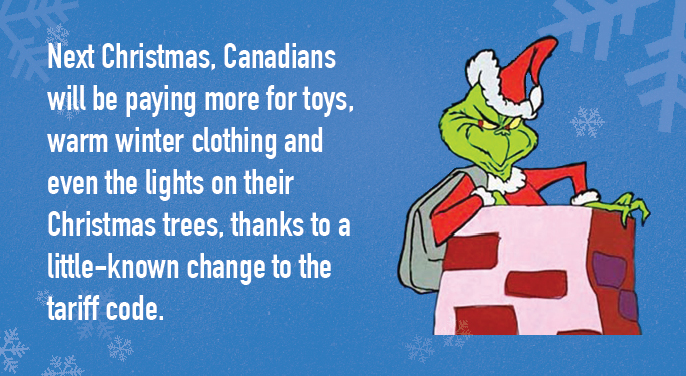December 22, 2014
The Grinches in Ottawa may not be stealing Christmas, but next year they are doing the next worst thing: taxing it.
Next Christmas, Canadians will be paying more for toys, warm winter clothing and even the lights on their Christmas trees, thanks to a little-known change to the tariff code.
In Budget 2013, the Federal government changed the tariff status of goods produced in over 50 countries, including India, China, Indonesia, Malaysia, Brazil, Thailand and Argentina. The new rules come into effect on January 1st, 2015 and will have Canadian consumers pay higher tariffs on over one thousand types of goods, ranging from toilet seats to coffins. The Federal government estimates Canadians will pay an extra $350 million each year in taxes due to these changes.

While the Federal government has not released a list of the affected goods or how much more revenue each tax increase will generate, we can estimate them using the World Bank’s WITS database. The WITS data shows that even small children will not escape these tax hikes, as the tariff on tricycles, wagons and dolls’ carriages is increasing from five to eight per cent. The tax increases on Timmy’s tricycle and Maggie’s little red wagon will cost kids (or more accurately, their parents) an estimated $16 million per year.
Christmas is also a fantastic time to introduce your kids to new hobbies. Many of us have fond childhood memories of fishing with our relatives. There will now be a 6.5 to seven per cent tariff on imports of fishing rods and fishing line, where previously these goods came in tariff-free, a move that will cost anglers $3 million per year.
Other hobbies are affected, as little artists will pay more for their brushes as they will now have a seven per cent tariff slapped on them, whereas they currently come in tariff free. Canadians will pay an extra $5 million each year for the class of products which includes brushes and brooms.
Want to surprise your loved one with a nice silver bracelet? Or perhaps they would prefer a new handbag or a writing desk for their home office? These will all see substantial tariff hikes. The tax increases on articles of jewellery made of precious metals will cost consumers an estimated $17 million each year. Consumers will pay an extra $22 million for the class of goods that includes handbags and suitcases and another $22 million for furniture.
Perhaps your loved one would prefer clothing. The tariff on silk blouses for women is rising from 10 per cent to a whopping 16 per cent, leaving Canadians $1 million poorer each year. Currently saris produced in India come in tariff free; after January 1st a six per cent import tariff will be slapped on them, costing consumer over one million dollars.
Let’s not forget a present for Fido! The import tariff on dog coats and other clothing products for animals is rising from 5 per cent to 7 per cent which will cost consumers an extra $700,000 per year.
These tariffs will add in a real and quantifiable way to the cost of many consumer goods.
Finally, perhaps your loved one would like a lamp, not unlike the one seen in A Christmas Story. The tariff increases on lamps and lighting fittings will cost Canadian consumers an estimated $17 million every year. This includes a 2 percentage point increase in the tariff on “lighting sets of a kind used for Christmas trees.”
These tariffs will add in a real and quantifiable way to the cost of many consumer goods. The federal government has announced initiatives to deal with high consumer prices, but the proposed initiatives are mostly symbolic, described as “cross-border Kabuki Theatre” by the Canadian Chamber of Commerce and “a feel-good announcement that will probably not have any effect at all” by the Consumer Association of Canada.
But the federal government is actually making real changes to the tariff code that will add to the cost of consumer goods. These are goods that Canadians buy all year round but it is worth pointing out, at this time of the year, how many of the items are holiday favourites. A real consumer agenda would begin by rolling back these tax increases on consumer goods. That would be a great Christmas present for Canadians all year around – and particularly next Christmas when they go to buy a new wagon or paint brush.






